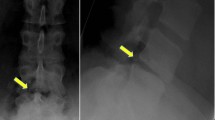Abstract
Objective
The purpose of this study was to assess the clinical and radiological outcomes of minimally invasive transforaminal lumbar interbody fusion (MI-TLIF) surgery for degenerative lumbar spine disease.
Methods
A prospective analysis of 34 consecutive patients who underwent a MI-TLIF using image guidance between July 2008 and November 2010. The patient group comprised 19 males and 15 females (mean age 56), 23 of whom had undergone additional reduction of spondylolisthesis. All patients underwent post-operative CT imaging to assess pedicle screw, cage placement and fusion at 6 months. Oswestry Disability Index (ODI) scores were recorded pre-operatively and at 6-month follow up.
Results
33/34 (97.1 %) patients showed evidence of fusion at 6 months with a mean improvement of 27 on ODI scores. The mean length of hospital stay was 4 days. The mean operative time was 173 min.
Complications observed
1/34 (2.9 %) suffered a pulmonary embolism and 1/34 (2.9 %) patients developed transient nerve root pain post-operatively. There were no occurrences of infection and no post-operative CSF leaks.
Conclusion
MI-TLIF offers patients a safe and effective surgical treatment option to treat degenerative lumbar spine disease.

Similar content being viewed by others
References
Cloward RB (1953) The treatment of ruptured lumbar intervertebral discs by vertebral body fusion. I: indications, operative technique, after care. J Neurosurg 10:154–168
Harms J, Rolinger H (1982) A one-stage procedure in operative treatment of spondylolisthesis: dorsal traction-reposition and anterior fusion [in german]. Z Orthop Ihre Grenzgeb 120:343–347
Sethi A, Lee S, Vaidya R (2009) Transforaminal lumbar interbody fusion using unilateral pedicle screws and a translaminar screw. Eur Spine J 18(3):430–434
Grob D (2009) Surgery for degenerative lumbar disease: transforaminal lumbar interbody fusion. Eur Spine J 18(12):1991–1992
Gejo R, Matsui H, Kawaguchi Y et al (1999) Serial changes in trunk muscle performance after posterior lumbar surgery. Spine 120:1023–1028
Rantanen J, Hurme M, Falck B et al (1993) The lumbar multifidus muscle five years after surgery for a lumbar intervertebral disc herniation. Spine 18:568–574
Sihvonen T, Herno A, Paljiarvi L et al (1993) Local denervation atrophy of paraspinal muscles in post operative failed back syndrome. Spine 18:575–581
Styf JR, Willen J (1998) The effects of external compression by three different retractors on pressure in the erector spine muscles during and after posterior lumbar spine surgery in humans. Spine 23:354–358
Foley KT, Lefkowitz MA (2002) Advances in minimally invasive spine surgery. Clin Neurosurg 49:499–517
Molinari RW, Bridwell SJ, Klepps SJ et al (1999) Minimum 5 year follow up of anterior column structural allografts in the thoracic and lumbar spine. Spine 24:967–972
Mannion R, Nowitzke A, Wood M (2010) Promoting fusion in minimally invasive lumbar interbody stabilisation with low dose BMP-2—but what is the cost? Spine J [E-pub prior to print]
Park P, Foley KT (2008) Minimally invasive transforaminal lumbar interbody fusion with reduction of spondylolisthesis: technique and outcomes after a minimum of 2 years’ follow-up. Neurosurg Focus 25:E16
Mura PP, Costaglioli M, Piredda M, Caboni S, Casula S (2011) TLIF for symptomatic disc degeneration: a retrospective study of 100 patients. Eur Spine J 20(Suppl 1):S57–S60
Faundez AA, Schwender JD, Safriel Y, Gilbert TJ, Mehbod AA, Denis F, Transfeldt EE, Wroblewski JM (2009) Clinical and radiological outcome of anterior-posterior fusion versus transforaminal lumbar interbody fusion for symptomatic disc degeneration: a retrospective comparative study of 133 patients. Eur Spine J 18(2):203–211
Schwender JD, Holly LT, Rouben DP et al (2005) Minimally invasive transforaminal lumbar interbody fusion (TLIF): technical feasibility and initial results. J Spinal Disord Tech 18(suppl 1):S1–S6
Schizas C, Tzinieris N, Tsiridis E et al (2009) Minimally invasive versus open transforaminal lumbar interbody fusion: evaluating initial experience. Int Orthop 33:1683–1688
Peng CW, Yue WM, Poh SY et al (2009) Clinical and radiological outcomes of minimally invasive versus open transforaminal lumbar interbody fusion. Spine 34:1385–1389
Villavicencio AT, Burneikiene S, Roeca CM et al (2010) Minimally invasive versus open transforaminal lumbar interbody fusion. Surg Neurol Int 1:12
Shunwu F, Xing Z, Fengdong Z et al (2010) Minimally invasive transforaminal lumbar interbody fusion for the treatment of degenerative lumbar diseases. Spine 35:1615–1620
Wang J, Zhou Y, Zhang ZF, Li CQ, Zheng WJ, Liu J (2011) Minimally invasive or open transforaminal lumbar interbody fusion as revision surgery for patients previously treated by open discectomy and decompression of the lumbar spine. Eur Spine J 20(4):623–628
Wang J, Zhou Y, Zheng Z et al (2010) Comparison of one-level minimally invasive and open transforaminal lumbar interbody fusion in degenerative and isthmic spondylolisthesis grades 1 and 2. Eur Spine J 19:1780–1784
Dhall SS, Wang MY, Mummaneni PV (2008) Clinical and radiographic comparison of mini-open transforaminal lumbar interbody fusion with open transforaminal lumbar interbody fusion in 42 patients with long-term follow-up. Neurosurg Spine 9:560–565
Isaacs RE, Podichetty VK, Santiago P et al (2005) Minimally invasive microendoscopy-assisted transforaminal interbody fusion with instrumentation. J Neurosurg Spine 3:98–105
Karikari IO, Isaacs RE (2010) Minimally invasive transforminal lumbar interbody fusion: a review of techniques and outcomes. Spine 35:S294–S301
Wu RH, Fraser JF, Hartl R (2010) Minimal access versus open transforaminal lumbar interbody fusion. Spine 35:2273–2281
Conflict of interest
None.
Author information
Authors and Affiliations
Corresponding author
Rights and permissions
About this article
Cite this article
Tsahtsarlis, A., Wood, M. Minimally invasive transforaminal lumber interbody fusion and degenerative lumbar spine disease. Eur Spine J 21, 2300–2305 (2012). https://doi.org/10.1007/s00586-012-2376-y
Received:
Revised:
Accepted:
Published:
Issue Date:
DOI: https://doi.org/10.1007/s00586-012-2376-y



